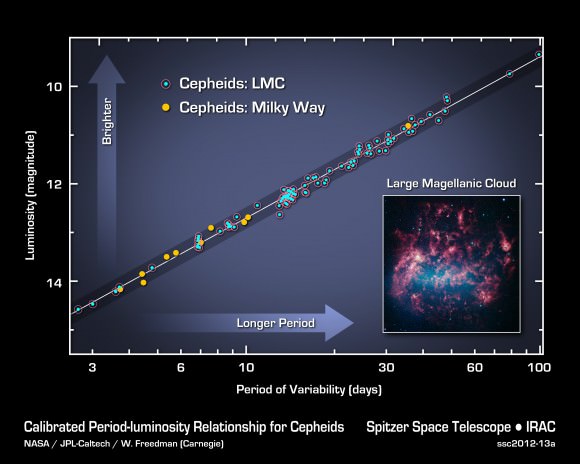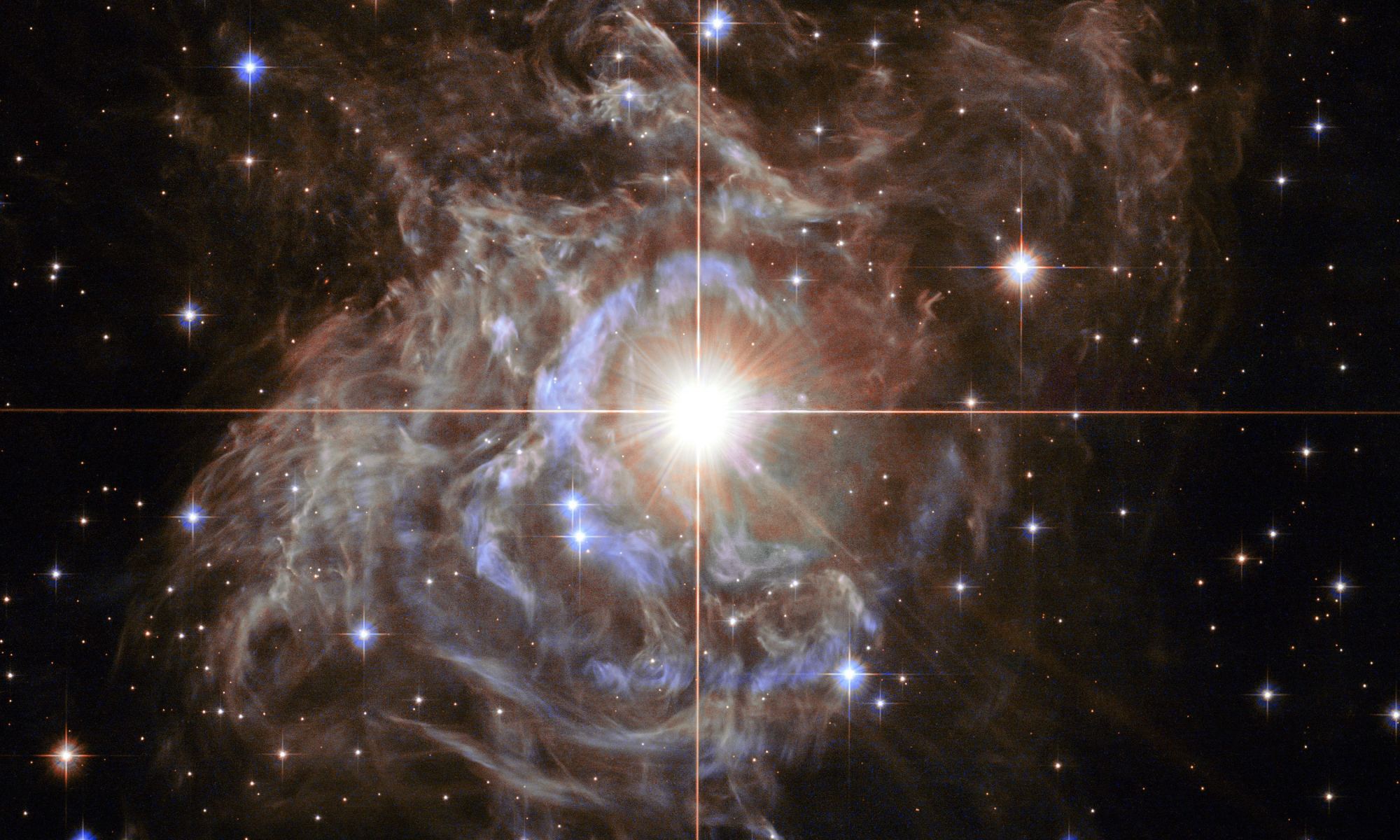One of the most fundamental questions astronomers ask about an object is “What’s its distance?” For very faraway objects, they use classical Cepheid variable stars as “distance rulers”. Astronomers call these pulsating stars “standard candles”. Now there’s a whole team of them precisely clocking their speeds along our line of sight.
What makes a classical Cepheid a “standard candle” in the darkness of the Universe? It’s that pulsation. Not only does a Cepheid grow larger in a regular rhythm, but its brightness changes over predictable periods of time. In the early 1900s, astronomer Henrietta Leavitt studied thousands of these stars. She found something pretty interesting: there’s a strong relationship between a Cepheid’s luminosity and its pulsation period. And that’s a useful relationship.
When you compare a Cepheid’s luminosity to its pulsation period, you can derive the star’s distance. This relationship appears to be true for all known Cepheids. That’s why they’re considered an important part of the cosmic distance ladder. They’re the main benchmark for scaling the huge distances between galaxies and galaxy clusters.
Types of Cepheids
There are different “flavors” of Cepheids. The “classical” ones have pulsation periods ranging from a few days to a few months. They’re all more massive than the Sun and can be up to a hundred thousand times more luminous. Their radii can change pretty drastically during a cycle—some grow by millions of kilometers and then shrink. Type II Cepheids have pulsation periods between 1 and 50 days and are usually very old, low-mass stars. There are other types, including anomalous Cepheids with very short periods. Scientists also know about double-mode Cepheids with “heartbeats” that pulsate in two or more modes.
Some pretty well-known stars are Cepheid variables. For example, Polaris—the well-known “North Star” is one, as is RR Puppis, Delta Cephei, and Eta Aquilae—all visible from Earth. Why these stars pulsate is still being studied but here’s a very basic look at their process. The core of the star produces heat which heats the outer layers. They expand, and then cool. Radiation is escaping, which makes the star appear brighter. The cooler gas contracts under gravity and makes the star look smaller and cooler. Of course, the devil is in the details, which is why astronomers want to know more about the processes these stars undergo.

However, it turns out Cepheids are not exactly easy to study. For one thing, it’s tough to measure their pulsations and radial velocities accurately. In addition, some have companion stars and the presence of a nearby star complicates any measurements. For another thing, different instruments and measuring methods give slightly different results, which doesn’t help astronomers understand those stars any better.
Precision Measurements of Cepheid Variables
Measuring the intricacies of Cepheid pulsations requires spectroscopic techniques that can measure light from stars and break it down into its component wavelengths. That reveals a lot of data about a star, including its chemical makeup, temperature, and motions in space.

A worldwide consortium of astronomers led by Richard I. Anderson at Switzerland’s École Polytechnique Fédérale de Lausanne (EPFL) is measuring specific properties of classical and other Cepheids using two high-resolution spectrographs. One is called HERMES on La Palma in the northern hemisphere and the other is CORALIE in Chile. They both detected tiny shifts in the light of target Cepheids. Those shifts gave valuable information about the motions of the stars.
“Tracing Cepheid pulsations with high-definition velocimetry gives us insights into the structure of these stars and how they evolve,” he said. “In particular, measurements of the speed at which the stars expand and contract along the line of sight—so-called radial velocities—provide a crucial counterpart to precise brightness measurements from space. However, there has been an urgent need for high-quality radial velocities because they are expensive to collect and because few instruments are capable of collecting them.”
VELOCE is on the Job
The team’s measurement project is called the VELOCE Project—short for VELOcities of CEpheids. It’s 12-year-long collaboration among astronomers and astrophysicists. Anderson began the VELOCE project during his Ph.D work at the University of Geneva, continued it as a postdoc in the US and Germany, and has now completed it at EPFL.
According to Ph.D student Giordano Viviani, the data from the project are already enabling new discoveries about Cepheids. “The wonderful precision and long-term stability of the measurements have enabled interesting new insights into how Cepheids pulsate,” Viviani said. “The pulsations lead to changes in the line-of-sight velocity of up to 70 km/s, or about 250,000 km/h. We have measured these variations with a typical precision of 130 km/h (37 m/s), and in some cases as good as 7 km/h (2 m/s), which is roughly the speed of a fast walking human.”
Uncovering New Details about these Pulsating Stars
The VELOCE project’s precision measurements also revealed some strange facts about these stars. For example, there’s an interesting phenomenon called the Hertzsprung Progression. It describes double-peaked bumps in a Cepheid’s pulsations. Astronomers aren’t quite sure yet why these bumps occur. But, they could give some insight into the structure of Cepheid variables, particularly the so-called “classical” ones.
Other Cepheids show very complex variability, and changes in their radial velocities are not always consistent with predicted periods, according to postdoctoral researcher Henryka Netzel. “This suggests that there are more intricate processes occurring within these stars, such as interactions between different layers of the star, or additional (non-radial) pulsation signals that may present an opportunity to determine the structure of Cepheid stars by asteroseismology,” Netzel said.
As part of their study, the team also measured 77 Cepheids that are part of binary systems. One in three Cepheids “lives” in a binary system, and often those unseen companions are detectable by velocity measurements. Characterizing the different “flavors” of Cepheids and the intricacies of their pulsations has larger implications than determining their radial velocities and bumps in their periods, according to Anderson. “Understanding the nature and physics of Cepheids is important because they tell us about how stars evolve in general, and because we rely on them for determining distances and the expansion rate of the Universe,” Anderson said, noting that VELOCE is also providing a valuable “cross-check” with Gaia measurements. It’s on track to conduct a large-scale survey of Cepheid radial velocity measurements.
Cross-checking with Gaia
Additionally, VELOCE provides the best available cross-checks for similar, but less precise, measurements from the ESA mission Gaia. That spacecraft is on track to conduct the largest survey of Cepheid radial velocity measurements. Data from that mission provides a growing three-dimensional map of millions of stars in the Milky Way and beyond. It not only charts their positions but also their motions (including radial velocity), as well as temperatures and compositions. Combined with high-precision data from VELOCE about Cepheids, astronomers should soon be able to get a handle on stellar and galactic evolutionary history.
For More Information
High-precision Measurements Challenge the Understanding of Cepheids
VELOcities of CEpheids (VELOCE)

